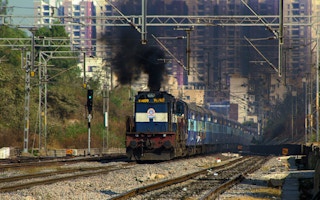As Europe’s cities seek to cut the emissions fuelling global warming and clear fume-filled air, one solution - restrictions on polluting cars - has sparked widespread protests, led to violent acts of vandalism and inflamed conspiracy theories.
From London to Rome, the introduction of Low Emission Zones (LEZs) and Ultra Low Emission Zones (ULEZs) has enraged some city residents, who say fines and charges imposed on the most polluting vehicles mean more hardship for society’s poorest during a global cost-of-living crisis.
More than 300 LEZs are already in place around Europe, and more than 500 are planned by 2025, according to Brussels-based environmental NGO Transport and Environment.
Here’s what you need to know about these measures.
Why were LEZs and ULEZs introduced?
LEZs and ULEZs aim to reduce the amount of nitrogen oxides (NOx), fine particles (PM10 and PM2.5), sulphur oxides (SOx), carbon monoxide(CO) and heavy metals released into the atmosphere by vehicles and are implemented in areas where air pollution levels are considered a danger to public health.
Poor quality air is linked to serious illnesses such as asthma, cardiovascular problems and lung cancer. Road transport also accounts for about a fifth of European Union emissions.
Roughly 70,000 premature deaths per year are attributed to vehicle pollution in Europe and the European Union has set targets to reduce air pollution-related deaths by 55 per cent by 2030.
Residents in towns and cities with the most traffic are most vulnerable to these effects - researchers call this the “pollution postcode lottery”. The areas with the worst air pollution also tend to be the poorest neighbourhoods, according to a Brussels-based study.
Where and why are people protesting against LEZs and ULEZs?
In London, where Mayor Sadiq Khan expanded the city’s ULEZ in August, hundreds of cameras used to enforce the rules have been vandalised and last December a camera was damaged in an explosion that police described as a reckless act.
Protesters have also taken to the streets of London to decry the policy and there have been demonstrations against LEZs and ULEZs in Belgium, Germany, and France.
In Brussels, the ‘Good Move’ plan to create low-traffic neighbourhoods has led to dozens of protests, with opponents spray-painting over cycling signs and dismantling traffic-calming barriers hours after they were installed in 2022.
In Spain, some right wing-run local authorities have pledged to reduce LEZs and reroute bicycle and bus lanes to accommodate cars.
The most simplistic version of the split between advocates and opponents pits the environment against the economy and this is playing out on a larger scale ahead of EU parliament elections this June.
Surveys show that while a large majority of Europeans support ambitious action to fight climate change, a majority is also worried about the cost of doing this.
Anger at everything from the EU’s Green Deal and high environmental standards to low food prices has already driven farmers onto the streets in several countries and some EU officials fear a drop in the broad support that climate policies have enjoyed since 2019.
The issue has also been politicised by various groups and is just one facet of a wider culture war, which also encompasses plans for 15-minute cities, speed limits, car-free zones and limits on the use of wood stoves in order to make cities more liveable.
Some of those who oppose ULEZs in the UK say that urban planning measures are part of a global conspiracy to take away people’s freedoms through mass surveillance and fines.
How do LEZs and ULEZs work?
The EU has progressively tightened road vehicle emission limits since the first set of regulations, known as “Euro 1”, were introduced in 1992.
Vehicle emissions are classified into ‘Euro standards’ - the higher the Euro standard the lower the emissions. Under this system, the most polluting vehicles are banned from designated zones while other non-compliant vehicles must pay to enter these areas. Older, diesel vehicles face the most restrictions.
Payments range from London’s £12.50 (US$16) daily charge to €35 (US$38) for a day pass in Brussels. Non-compliant vehicles incur a levy or a fine and these range from €68-450 in Paris to £90-£180 in London.
European cities have different rules regarding which cars are exempt. In London, for example, most petrol vehicles under 16 years old and diesel vehicles less than six years old are exempt.
Italy has the most LEZs, followed by Germany, according to the Urban Access Regulations website.
Central and Eastern European countries have been slower to establish LEZs - with restrictions to kick in during the second half of 2024 in the Polish cities of Warsaw and Krakow.










